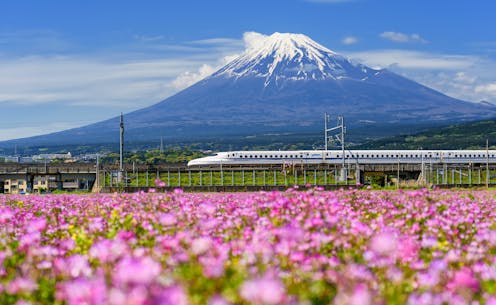Is the shine coming off Japan’s bullet trains?
- Written by Taku Tamaki, Lecturer in International Relations, Loughborough University

Just ten days before the 1964 Tokyo Olympic Games, Japan opened[1] its Tōkaidō Shinkansen, a high-speed rail line connecting Tokyo with Osaka. Shinkansen bullet trains showcased the high quality of Japanese railway technology to the world, with trains travelling at up to 285 km/h (177 mph).
More than ten trains depart from Tokyo each hour, and the average delay[2] remains at just 54 seconds per train – much lower[3] than in other countries such as the UK. So far, Japan’s bullet trains have also recorded zero passenger fatalities in their 60 years of operation.
The reliability, punctuality and safety of Japanese railways has reinforced[4] the country’s identity as a self-professed railway technology superpower.
However, Japan’s Shinkansen is a self-contained railway system designed to be isolated from the conventional railway network. For example, the system is a dedicated high-speed line with a wider track than the rest of the network. This means that the bullet train’s good reputation, which has been nurtured over decades, is predicated on it being a standalone project.
The irony here is that while Japanese suppliers have developed high technical know-how, their skills are being wasted as they struggle to adapt to the international railway marketplace.
In late 2023, Japan expressed its reluctance to join Indonesia’s US$7.3 billion (£5.9 billion) high-speed rail project, citing concerns[5] about technical compatibility and possible damage to its “brand”. As a result, Indonesia picked China[6] to build the railway instead. China also offered to do it faster and with fewer conditions.
My own research[7] suggests that domestic pride and confidence will turn into anxiety as Japanese railway expertise continues to encounter overseas rivals, and fails to win contracts.
The Taiwanese experience
Japan has successfully exported[8] its “high quality” rail infrastructure to Taiwan, India, Europe and the UK in the past. But Japan’s experience of exporting bullet train technology to Taiwan in the late 1990s and early 2000s remains a cautionary tale.
The Taiwanese high-speed railway, a 350km line that runs along the west coast of the country, resulted in a mix of European and Japanese technologies after much political haggling. The Japanese engineers were worried that their bullet trains had to run on European tracks, an engineering requirement not anticipated by the Shinkansen technology.
They feared[9] that the bullet train’s international reputation would suffer if anything went wrong in the process of mixing Japanese and European designs.
Thankfully, nothing has gone wrong. But this episode shows how Japanese engineers are obsessed with making sure the bullet train technology is sold as a complete package.
This is an example of the “Galapagos Syndrome”[11], a metaphor used to describe products and services that have developed with a focus on a single market or culture, making them distinct when compared to the rest of the world. The reputation of the bullet train rests on not mixing with non-Japanese technology.
The experience in Taiwan also highlighted another dimension of Japanese railway expertise: that Japanese manufacturers lack the necessary expertise to compete in the international railway marketplace where the mixing of technology from various countries is the norm.
Future risks
The Japanese government has recently announced[12] that it would back a bid from Japanese companies to export underground railway expertise[13] and technology to the Dominican Republic. The Caribbean country is planning to expand its underground railway system mainly in its capital, Santo Domingo.
Japan’s involvement makes sense given its experience operating rapid mass transit systems. This sort of system already operates in major Japanese cities like Tokyo, Yokohama, Kobe and Fukuoka. However, there is a risk that the Japanese system remains incompatible with what is available from the international marketplace.
Unless the Japanese system is compatible internationally, then the operator will remain stuck with Japanese technology when the time comes for renewal. Otherwise, they will need to find a non-Japanese supplier willing and able to shoehorn their technology into the Japanese system.
This predicament is reminiscent of Taiwan’s recent struggle[15] to renew its high-speed trains. The original trains that Japan sold to Taiwan are now due for refurbishment. And the Taiwanese operator has had to choose between purchasing brand new trains either from different Japanese manufacturers or from European suppliers.
Purchasing new trains from Japan meant incurring additional costs, while procuring European rolling stock would result in the greater complexity of having a mixed fleet. In the end, the Taiwanese operator opted to purchase[16] new trainsets from Japanese firms Hitachi and Toshiba.
Japan’s self-image is built on the notion that the Japanese technology is the best in the world. But Japan’s government and railway industry still have a lot to learn from the international marketplace. For now, Japanese confidence will have to cohabitate with anxiety.
References
- ^ opened (www.theguardian.com)
- ^ average delay (global.jr-central.co.jp)
- ^ much lower (dataportal.orr.gov.uk)
- ^ reinforced (www.ejrcf.or.jp)
- ^ concerns (asianews.network)
- ^ China (moderndiplomacy.eu)
- ^ research (www.tandfonline.com)
- ^ exported (www.railway-technology.com)
- ^ feared (www.globalconstructionreview.com)
- ^ AaronChenPS2/Shutterstock (www.shutterstock.com)
- ^ “Galapagos Syndrome” (www.mizuhogroup.com)
- ^ announced (wicnews.com)
- ^ underground railway expertise (www.metro-magazine.com)
- ^ EQRoy/Shutterstock (www.shutterstock.com)
- ^ struggle (www.taipeitimes.com)
- ^ purchase (www.hitachi.com)
Read more https://theconversation.com/is-the-shine-coming-off-japans-bullet-trains-225129







